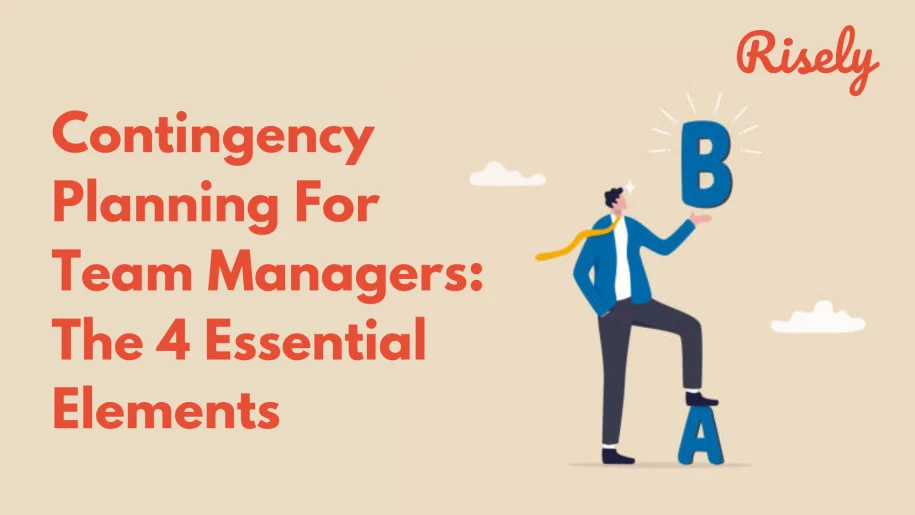Contingency Planning For Team Managers: The 4 Essential Elements
Contingency planning is an essential part of any manager’s job. Why? Because no one knows the future – and that includes managers! As unpredictable events happen worldwide, managers need to plan for potential situations that can harm the team. A contingency plan allows them to account for possible uncertainties and plan responses if those uncertainties materialize. It can help minimize disruptions’ impact on the team’s functioning and ensure more consistent performance despite the uncertainties. This way, they can react swiftly and efficiently when something does happen. In this article, we’ll explore why contingency planning is so important and give tips on how to do it effectively.What is contingency planning?
Risk management is the process of identifying, assessing, and managing the risks associated with a team’s operations. One might think such a topic is only relevant at the organizational level. But, in fact, it is vital at every team level in the organization. One of the critical elements of risk management is contingency planning. It involves identifying potential risks and planning responses to contingencies that might arise from those risks. It helps managers anticipate potential problems and devise strategies to address them. Contingency planning is a critical part of any team’s risk management plan, as it allows for the management of risk in a proactive and risk-informed manner.Why is contingency planning important for managers?
Contingency planning is essential for managers for the following reasons:- Continuation of operations- First and foremost, contingency planning is essential for ensuring the continuity of business operations in the event of an unexpected event. By being prepared for potential risk factors and implementing a plan of action should they arise, managers can minimize the disruption caused by an unforeseen situation.
- Manage Risk- A good contingency plan will help you proactively manage risk. By anticipating potential problems and planning, you reduce the chances that an actual issue will become severe enough to disrupt your team operations.
- Responsiveness- A good contingency plan will be responsive to changes in the business environment. By being agile and able to adjust your plans as needed rapidly, you can ensure that you are always prepared for whatever might come your way.
- Restore confidence- Finally, a well-executed contingency plan can help restore confidence in the management team and internal stakeholders. You can do this by demonstrating that you are taking proactive steps to address potential risks. By being open and transparent about your risk management processes, you can build trust and credibility with those who matter most – your employees and customers.
Other Interesting Reads
Elements of a good contingency plan
Contingency planning is critical for managers because it helps minimize business disruption risk. A contingency plan should include the following key elements:1. Identification of risks and challenges
Identification of risks and challenges is an essential element of a contingency plan that managers do make. A failure to correctly identify and assess risks and challenges can create significant problems when an organization faces an unexpected event. There are a variety of methods that one can use to identify risks and challenges. Some common techniques include brainstorming, checklists, interviewing stakeholders, and reviewing past events. Once you identify risks and challenges, you can assess them for their potential impact and likelihood. You can use this information further in the process to develop contingency plans that address the most likely and impactful risks and challenges.2. Brainstorming potential solutions
After a manager has identified risks, it is vital for them to brainstorm possible solutions as part of a contingency plan. This process of brainstorming possible solutions can help managers understand the risks better and develop a plan of action to mitigate them. There are a few different techniques that you can use when brainstorming possible solutions. Mind mapping is a popular approach that involves creating a visual representation of the problem and possible solutions. This can help see the big picture and understand the interrelationships between different elements. Another helpful technique is SCAMPER, which stands for Substitute, Combine, Adapt, Modify, Put to Another Use, Eliminate, and Reverse. This technique can generate new ideas by looking at the problem differently.3. Putting a plan into action
Brainstorming possible solutions is an essential part of a contingency plan for managers. Developing a plan to implement solutions is the critical next step. This process for putting a plan into action after brainstorming possible solutions is as follows:- The first step is to develop a list of possible solutions
- The second step is to select the most promising solution
- The third step is to create a plan to implement the solution
- The fourth step is to test the plan
- Further, the fifth step is to implement the plan
- At last, the sixth step is to evaluate the results
4. Monitoring the plan and adjusting as needed
After implementing a plan, it is vital to monitor the situation and make changes to the plan as needed. That helps ensure that the plan is effective and that it can be tweaked as necessary to better respond to the situation. Part of monitoring the situation includes being aware of new information or changes that could affect the plan. Additionally, it is essential to review the plan regularly to see if it is still relevant or needs to be updated. Things change over time, and what worked yesterday might not work today. By reviewing the plan on a regular basis, you can ensure that it is still effective and that it meets the needs of your company.Conclusion
Contingency planning is a vital part of any manager’s job. It allows you to plan for unexpected events and contingencies, ensuring your business runs smoothly and without disruption. In addition, contingency planning provides a basis for making informed decisions about strategic investments, helping to ensure that the organization is in a good position for future growth. By understanding the elements of a good contingency plan listed above, you can create a plan tailored to your specific business needs. Make sure to check back later for more helpful advice on contingency planning.Download the free problem solving toolkit to deal with contingencies effectively.
Learn the roadmap to problem solving and identify weak areas in your strategies.
Why is contingency planning important for managers?
Contingency planning is important for managers to ensure that their team remains safe from the impact of uncertainities and abrupt changes in the environment which can disrupt their plans. It acts as a safeguard against chaos in the face of unanticipated challenges.
How do managers use contingency approach?
As per the contingency approach to management, managers follow that their approach to management is dependent on scenario. It is believed that there is no ultimately correct approach which can be consistently applied across all scenarios.
What is an example of contingency view in management?
For instance, a leader may use a directing style when the followers are new to a task and lack the necessary skills and knowledge to complete it. In contrast, a delegating style may be more appropriate when the followers are experienced and capable of handling the task independently. The situational leadership model highlights the importance of adapting leadership styles to meet the needs of different situations and followers, which is a key aspect of the contingency view in management.
Other Related Blogs
Know the best sales manager 30 60 90 day plan to be an efficient leader
Know the best sales manager 30 60 90 day plan to be an efficient leader Are you a sales manager looking to make a strong impression on your new team…
Manager Effectiveness: A Complete Guide for Managers in 2024
Manager Effectiveness: A Complete Guide for Managers in 2024 Manager effectiveness is everyone’s favorite buzzword. But the road to achieving it is trickier than it looks like! While manager effectiveness…
5 Steps Training Needs Assessment Model: Why It Is Important For Employees?
5 Steps Training Needs Assessment Model: Why It Is Important For Employees? Have you ever wondered why some training programs hit the bullseye while others miss the mark? Well, it’s…
5 Steps of Developing an Effective Training Evaluation Program: With Best Practices
5 Steps of Developing an Effective Training Evaluation Program: With Best Practices Have you ever wondered how effective those training initiatives truly are? How do you know if they’re making…


